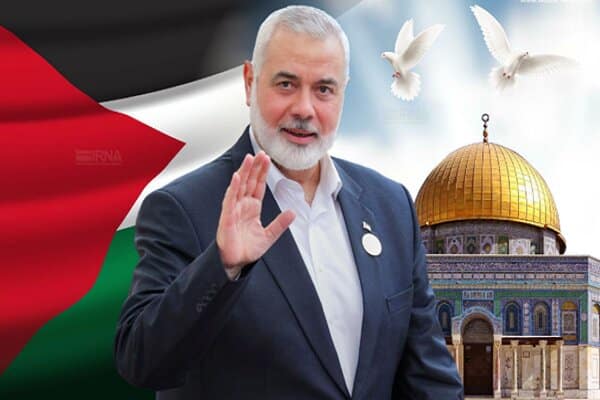“Assassination” Israel’s failed policy to escape from the consequences of the great defeat of October 7.
The Al-Aqsa storm operation, which was carried out by Hamas forces on October 7, 2023, and the subsequent resistance by various Palestinian groups, have stunned the security and political authorities of the Zionist regime. One of the most important points about this operation is the failures that this regime has suffered. These failures caused the leaders of this regime to put the assassination of resistance leaders on the agenda, the most important of which was the assassination of Ismail Haniyeh, the leader of Hamas, in Tehran.
terror policy; The security strategic principle of the Zionist regime
Throughout history, survival has been a decisive factor for Zionists, and security is a focal point in the history of Zionism. Since the formation of Israel, the Zionist settlers have always felt under siege and believe that if they lose just one war, not only their state but also themselves will be destroyed.
Many Zionists have participated in the struggle against the Palestinian resistance, and in some way they have all been involved in the war with the Palestinian resistance. Naturally, this situation has had an impact on shaping the political environment and even the government. Most of the Zionist prime ministers and ministers have been soldiers. They have issued orders to kill many people and probably sent a large number to be killed.
Assassination of Palestinian leaders
The most important assassinations of the Zionist regime are related to the leaders of Palestinian groups. Assassination of Palestinian political leaders and military commanders, especially members of the Hamas group, has always been on the agenda of the Zionists. So far, many people have been physically removed and martyred by Zionist spy organizations. Two months after the second intifada occurred in September 2000, the Zionist regime openly announced its policy of terror. Yahya Ayash, a member of Hamas, was one of the most important people who was assassinated in Gaza in 1996. In addition, 11 Palestinian political leaders were assassinated between 2000 and 2005.
The most important Palestinian leaders who were assassinated during the second intifada are: Thabit Ahmad Thabit of Fatah in December 2000, Jamal Salim of Hamas in July 2001, Jamal Mansour of Hamas in July 2001, Abu Ali Mustafa of the Popular Front for the Liberation of Palestine in August 2001, Jihad Ahmad Jibril of the Popular Front for the Liberation of Palestine in May 2002, Salah Shahadeh of Hamas in July 2002, Ibrahim al-Maqdama of Hamas in March 2003, Ismail Abu Shatab Hamza of Hamas in August 2003, Sheikh Ahmed Yassin of Hamas in March 2004, Abdul Aziz Rantisi of Hamas in April 2004, Adnan al-Ghul of Al-Qassam Brigades of Hamas in 2004 and Ezzedine Khalil of Hamas in September 2004, Mohammad Al-Zawari, the father of the drone of Al-Qassam Brigades in 2016 in Tunisia and Saleh al-Arouri, the deputy head of the political office of Hamas in 2024 in Beirut.
Esmail Haniyeh, the head of the political office of Hamas, was also assassinated in 2024 in Tehran. The assassination of Ismail Haniyeh is the latest assassination of Palestinian leaders by the occupation regime. It seems that the assassination of the political leader of Hamas, who played a prominent role in the ceasefire negotiations, is the result of multiple failures that have made this regime inactive in various fields.
Information failure
The most important failure of the Zionist regime during the Al-Aqsa storm was the failure to predict its occurrence. Despite security organizations such as the IDF, Shin Bet, Mossad, etc., the October 7th operation seems unbelievable. In a report, the experts of the think tank of the Center for Strategic and International Studies considered this attack to be one of the most difficult attacks. But the main failure of the intelligence agencies of the Zionist regime and its supporters was in not recognizing the real power of Hamas. As one of the experts of the aforementioned think tank says, it was proven before October 7 that Hamas is more capable than what its recent operations showed.
Failure to destroy Hamas in the field
One of the most important failures of the Zionist army is the ineffectiveness of the military strategy that was emphasized from the beginning. The leaders of the Zionist regime, including Netanyahu, promised to destroy Hamas and its members in less than a few months after facing the Al-Aqsa storm. But now it has become clear that this approach is not effective. In a June 2024 article in Foreign Affairs, Robert Pipe titled “Hamas Wins; Why does Israel’s strategy of defeat make its enemy stronger?” He believes: “Hamas and its goals are more popular and attractive today than on October 7th. After 10 months of war, it’s time to recognize the bitter reality: there is no military solution only to defeat Hamas.
He further adds: “Hamas has neither failed nor is it on the verge of failure.” (Regime) Israel attacked the north and south of Gaza with about 40,000 soldiers, forcibly displaced 80% of the population, killed more than 39,000 people, and dropped at least 70,000 tons of bombs on this area. It destroyed more than half of Gaza’s buildings, limited the region’s access to water, food, and electricity, and put the entire population on the brink of famine. The main flaw in the strategy of the Zionist regime is not the failure of tactics or the imposition of restrictions on military force, but the failure in not predicting the sources of power of Hamas.

